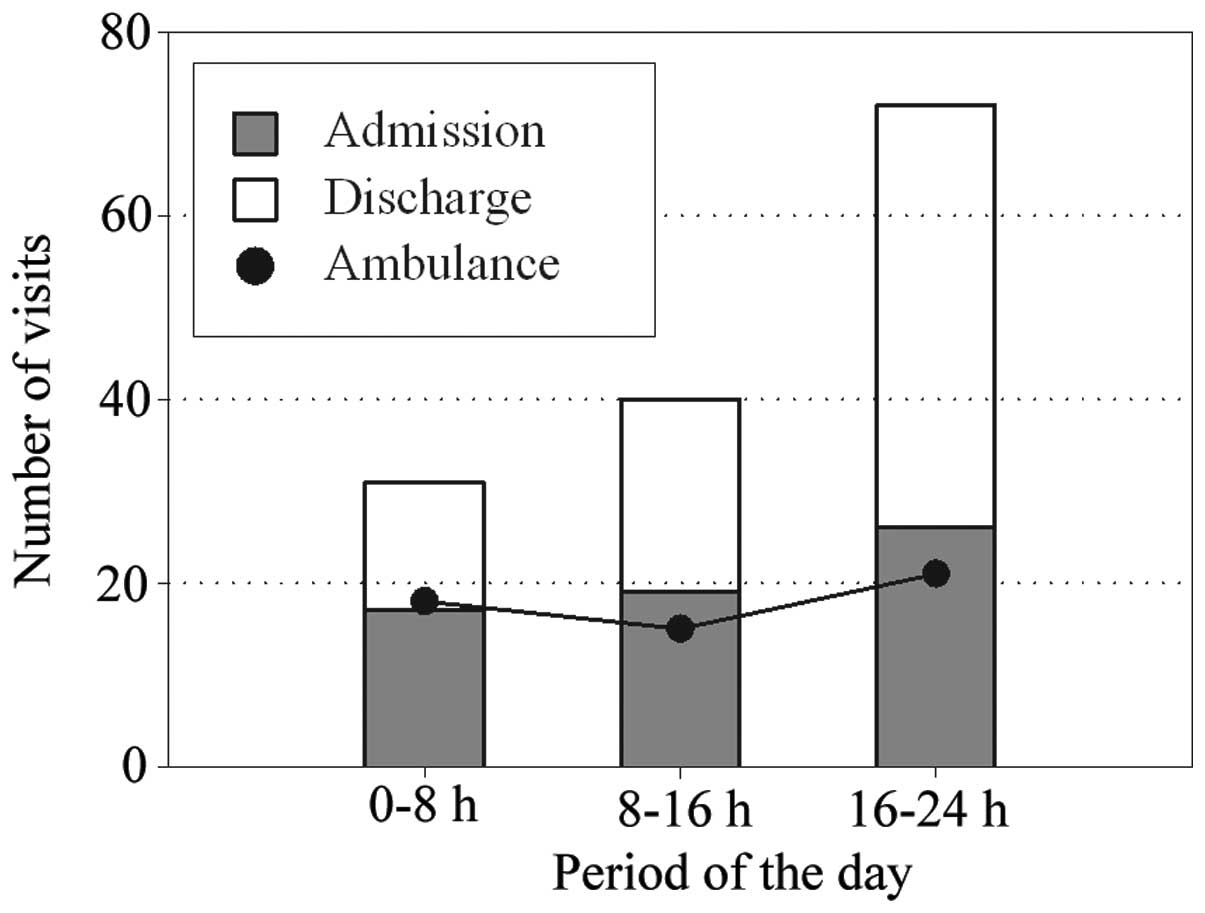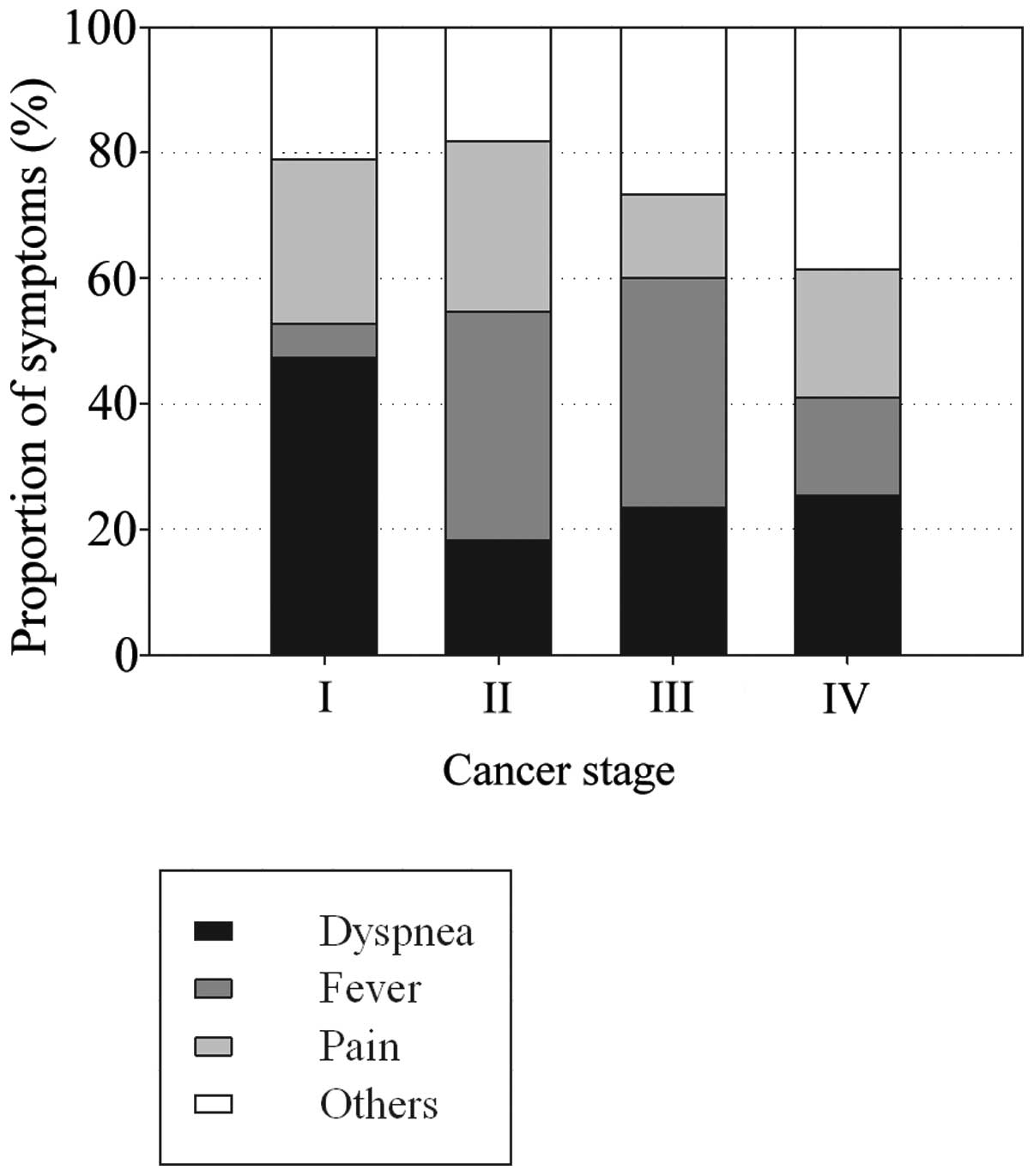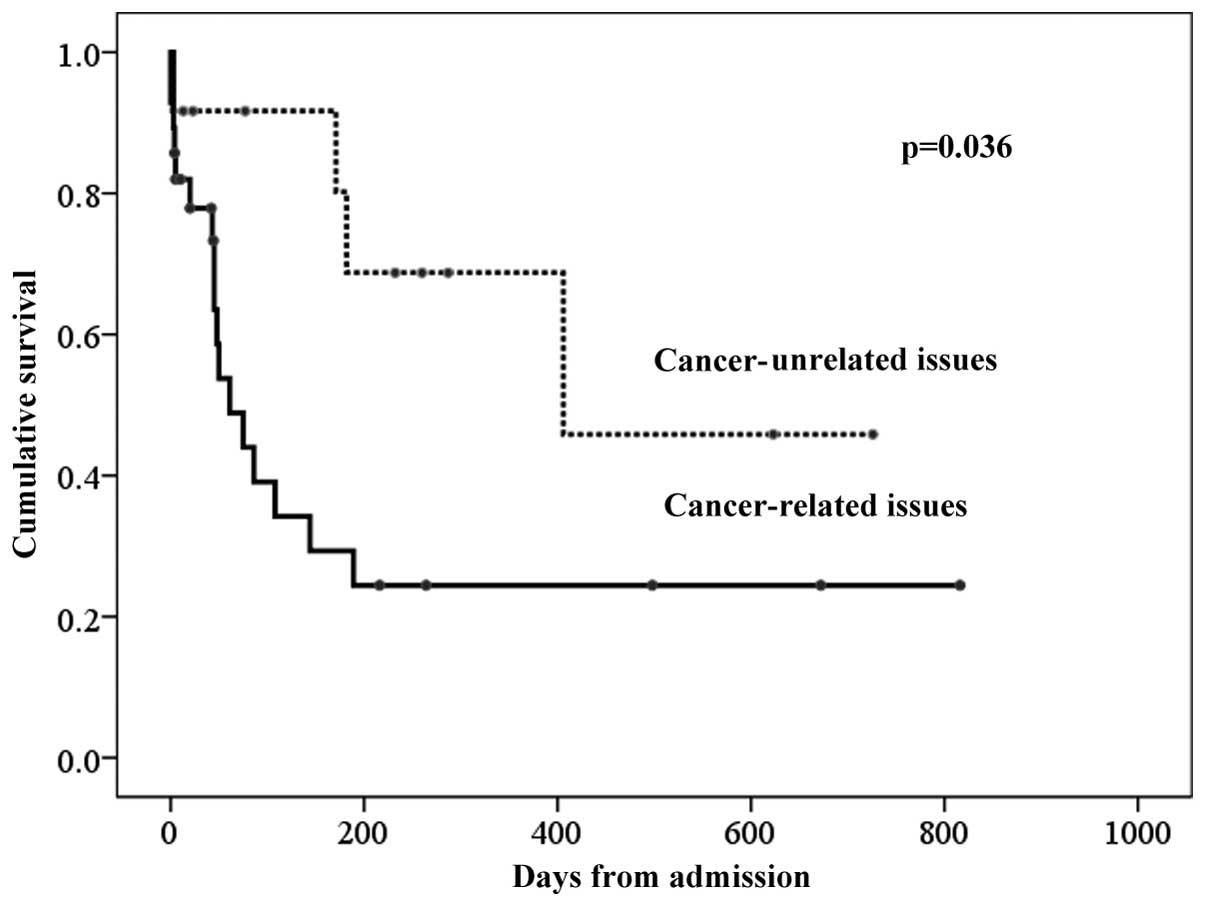Lung cancer patients frequently visit the emergency room for cancer‑related and -unrelated issues
- Authors:
- Published online on: January 13, 2014 https://doi.org/10.3892/mco.2014.241
- Pages: 322-326
Abstract
Introduction
Lung cancer is the leading cause of cancer-related mortality. Lung cancer patients are treated in outpatient clinics, where systemic chemotherapy is administered. In addition, due to the short survival time of advanced-stage patients, palliative care is often provided at home in Japan and other countries.
Cancer patients frequently require emergency medical care due to acute unbearable symptoms and life-threatening conditions. In lung cancer particularly, the visits to the emergency room (ER), admission to hospital from the ER and death in the ER are more frequent compared to those in other types of cancer (1,2). Mayer et al (3) investigated 37,760 cancer-related ER visits in North Carolina, 9,297 of which were made by patients with lung cancer (26.9%). Temel et al (4) reported that 48% of patients with advanced non-small-cell lung carcinoma (NSCLC) visited the ER within the 30 days preceding death. Moreover, only 32% of patients with lung cancer who were admitted to the intensive care unit (ICU) survived and only 11% of those who received mechanical ventilation remained alive after 6 months (5). Although frequent visits to the ER and poor prognosis are common in lung cancer, no study has yet discriminated between cancer-related and -unrelated issues as reasons for the ER visits.
It may be beneficial to avoid aggressive treatment in end-of-life patients with advanced disease if cancer-related issues are immediately diagnosed. By contrast, diseases which are unrelated to cancer should be treated aggressively. For the purpose of determining the appropriate emergency care of lung cancer patients, we retrospectively overviewed the characteristics of their ER visits.
Materials and methods
Sampling data from medical records
The medical records of consecutive lung cancer patients who visited the ER between January, 2010 and December, 2011 were retrospectively reviewed. All the patients were classified by histopathology and clinical stage at presentation in the ER. The time of the visits was divided into night (0–8 h), day (8–16 h) and evening (16–24 h). The means of arrival at the hospital (e.g., ambulance or walk-in), admission/discharge from the ER and hospital mortality were surveyed. The chief complaint was defined as the main symptom causing the visit to the ER.
The patients’ diagnoses were classified as cancer-related or -unrelated diseases on arrival at the ER. A cancer-related issue was defined as symptoms caused by the cancer itself (primary site and/or distant metastasis), endocrinological disorders induced by the cancer and/or adverse effects of the treatment, such as chemotherapy, radiotherapy and surgery. Cancer-unrelated diseases were defined as comorbidities (chronic diseases or acute syndromes) incidentally occurring in patients with cancer.
This retrospective, single-institution, observational study was approved by the Institutional Review Board of Saitama Medical University International Medical Center in 2012.
Statistical analyses
The number of visits, proportion of cancer-related issues, admission and hospital mortality were calculated for patients at each cancer stage. The differences in the chief complaints between patients with cancer-related vs. those with cancer-unrelated diseases were also assessed using the Chi-square test. The frequency of the major chief complaints in patients at different clinical stages was visualized by plotting histograms. The survivals of stage IV patients admitted through the ER were compared using the Kaplan-Meier method. P<0.05 was considered to indicate a statistically significant difference.
Results
Patients
Over a period of 2 years (2010–2011), 113 patients with lung cancer visited the ER a total of 143 times (1.34% of the total of 10,642 ER visits during that period). The lung cancer patients were diagnosed as follows: 11 patients had small-cell lung carcinoma (SCLC) and 102 had NSCLC, of whom 25 had squamous cell carcinoma, 76 non-squamous cell carcinoma, with one patient remaining unclassified. Among the 76 non-squamous cell carcinoma cases, 24 harboured epidermal growth factor receptor (EGFR) mutations. Of the 143 visits, the time from diagnosis of lung cancer to visiting the ER was 14.2±17.5 months. The number of patients at each clinical stage on presentation at the ER was 19 stage I, 13 stage II, 30 stage III and 81 stage IV patients. The treatments administered within 4 weeks included surgery (10), radiotherapy (7), chemotherapy (46), tyrosine kinase inhibitor (19) and palliative care alone (61). The majority of the patients (92.6%) were regularly followed by medical oncologists in our institution (Table I).
Approximately half of the patients visited the ER in the evening (16–24 h), although the numbers of those requiring use of an ambulance and those admitted were independent of the time of day (Fig. 1).
Chief complaints
Respiratory symptoms (34.3%), pain (24.3%), gastrointestinal (12.9%) and neurological signs (12.9%) and fever (10.0%) were the most common complaints in patients with cancer-related issues, whereas fever (30.1%), respiratory symptoms (28.8%), pain (16.4%), gastrointestinal (9.6%) and neurological signs (9.6%) were the predominant cancer-unrelated issues.
The chief complaints were stratified by the defined criteria of cancer-related and -unrelated issues provided in Materials and methods. With one exception, there were no significant differences in the frequency of the complaints; fever was significantly more frequent among patients with cancer-unrelated compared to those with cancer-related issues (P<0.01) (Table II). It was not possible to distinguish between cancer-related or -unrelated issues on the basis of the chief complaints at presentation in the ER.
Causes of cancer-related and -unrelated issues
A total of 70 visits (49.0%) were classified as being caused by cancer-related issues and the remaining 73 (51.0%) as being due to cancer-unrelated diseases (Table III). Among cancer-related issues, direct invasion or distant metastasis were the most common causes (n=31). A total of 17 visits were associated with the effects of cancer treatment, such as chemotherapy, radiotherapy and surgery. The most common causes of cancer-unrelated issues included infection, cardiovascular symptoms and gastrointestinal events.
Patients who required admission to the hospital from the ER included 33 patients with cancer-related issues and 29 with diseases unrelated to cancer. Brain metastasis was the most frequent cancer-related issue, whereas respiratory problems were the main causes of admission for cancer-unrelated reasons. A total of 8 patients with cancer-related issues and 6 with cancer-unrelated diseases succumbed in the hospital.
Association between ER use and cancer stage
With cancer stage progression, the number of ER visits, admissions, ambulance use and hospital mortalities were increased. The proportion of patients who visited the ER due to cancer-related reasons was significantly higher among stage IV patients compared to that among patients with earlier-stage disease (P<0.01). This also applied to admission (P<0.05) and ambulance use (P<0.01) (Table IV). As regards the three major symptoms (dyspnea, fever and pain), dyspnea was the reason for almost half the visits by stage I patients, whereas fever was common in stage II/III patients and the symptoms were variable in stage IV patients (Fig. 2).
The overall median survival time (MST) of stage IV patients from emergency admission was 144 days. The patients admitted for cancer-related reasons exhibited a significantly shorter MST compared to those admitted for cancer-unrelated disease (61 vs. 406 days, respectively; P<0.05) (Fig. 3), indicating the validity of distinguishing between cancer-related and -unrelated cases.
Discussion
This study demonstrated that outpatients with lung cancer visited the ER at a similar frequency for cancer-related as well as -unrelated reasons. We were unable to distinguish between the two on the basis of their chief complaints; however, fever was predominant among patients with cancer-unrelated problems. Respiratory symptoms were common in patients with either cancer-related or -unrelated issues. Cancer-related dyspnea was predominant in advanced stages. Among the cancer-unrelated issues, respiratory problems, such as respiratory tract infection and chronic lung diseases, were commonly encountered. Fever was frequently observed in patients visiting the ER for cancer-unrelated issues for the same reason. Neutropenic fever following chemotherapy was not often seen, which was consistent with the findings of previous studies (3,6). However, neutropenic fever should be diagnosed with caution due to its significant morbidity and mortality (7).
Furthermore, in contrast to hospitalization for stage IV lung cancer, the patients admitted for cancer-unrelated issues had a relatively good prognosis. Thus, immediate diagnosis at ER presentation is crucial for deciding on either intensive or palliative care. End-of-life cancer care has become more aggressive over the years (8). However, a previous cohort study reported that 48% of the patients with advanced NSCLC visited the ER within the month preceding death (4). Another study reported that only 32% of lung cancer patients admitted to the ICU survived and only 11% of those requiring mechanical ventilation remained alive after 6 months (5). Aggressive end-of-life cancer care may thus be counterproductive in terms of the patient’s quality of life and the utilization of medical resources.
For the purpose of accurate diagnosis of treatable cancer-related and -unrelated issues at presentation in the ER, we recommend whole-body computed tomography to evaluate cancer progression. Blood sampling may be useful for differential diagnosis. Other possible tools for rapid diagnosis in the ER are reportedly lung ultrasound (9) and B-natriuretic peptide assay (10,11).
There were certain limitations to the present study. First, the study was conducted at a single institution and the results may not be representative of all lung cancer patients at different centers. Second, there are differences in place of death between Western countries and Japan. The majority of the patients die in the hospital in Japan, whereas ~50% of lung cancer patients die at home in the US (4). Third, although we classified patients into those with cancer-related and those with cancer-unrelated issues on the basis of reviewing their medical records, it is possible that the two types coexisted in some cases.
Visiting the ER for cancer-related issues may reflect inadequate management during routine cancer care (12). The control of dyspnea is particularly important, as was reflected by the fact that dyspnea was the most frequent reason for visiting the ER (3), as well as for emergency admission; dyspnea was also associated with poor prognosis (13–15). In order to control dyspnea by regular routine care, opioids, corticosteroids and home oxygen should be properly administered by oncologists. Previous studies demonstrated that earlier and more frequent palliative care consultations and greater family physician continuity of care for terminal cancer patients resulted in a lower incidence of ER visits (8,16). Another previous study revealed that lung cancer patients who succumbed in an acute care hospital were more likely to have presented with progressive thoracic symptoms compared to those who died elsewhere (17). It was also reported that patients preferred direct admission to the oncology ward compared to admission through the ER (18).
Our study may contribute to the optimization of the emergency care for lung cancer patients. However, further studies should be conducted for each of the emergency issues associated with lung cancer.
In conclusion, a similar fraction of outpatients with lung cancer visited the ER due to cancer-related and -unrelated events. Accurate differential diagnosis at presentation in the ER is crucial for allotting appropriate emergency care to patients with lung cancer.
Acknowledgements
We would like to thank NAI Inc. for the English editing of our manuscript.
References
|
Barbera L, Taylor C and Dudgeon D: Why do patients with cancer visit the emergency department near the end of life? CMAJ. 182:563–568. 2010. View Article : Google Scholar : PubMed/NCBI | |
|
Leak A, Mayer DK, Wyss A, Travers D and Waller A: Why do cancer patients die in the emergency department? An analysis of 283 deaths in NC EDs. Am J Hosp Palliat Care. 30:178–182. 2013. View Article : Google Scholar : PubMed/NCBI | |
|
Mayer DK, Travers D, Wyss A, Leak A and Waller A: Why do patients with cancer visit emergency departments? Results of a 2008 population study in North Carolina. J Clin Oncol. 29:2683–2688. 2011. View Article : Google Scholar : PubMed/NCBI | |
|
Temel JS, McCannon J, Greer JA, et al: Aggressiveness of care in a prospective cohort of patients with advanced NSCLC. Cancer. 113:826–833. 2008. View Article : Google Scholar : PubMed/NCBI | |
|
Slatore CG, Cecere LM, Letourneau JL, et al: Intensive care unit outcomes among patients with lung cancer in the surveillance, epidemiology, and end results-medicare registry. J Clin Oncol. 30:1686–1691. 2012. View Article : Google Scholar : PubMed/NCBI | |
|
McKenzie H, Hayes L, White K, et al: Chemotherapy outpatients’ unplanned presentations to hospital: a retrospective study. Support Care Cancer. 19:963–969. 2011. | |
|
Cull LF and Nolan MB: Treating neutropenic fever in the emergency department: delays may be deadly! J Emerg Nurs. 35:36–39. 2009.PubMed/NCBI | |
|
Gonsalves WI, Tashi T, Krishnamurthy J, et al: Effect of palliative care services on the aggressiveness of end-of-life care in the Veteran’s Affairs cancer population. J Palliat Med. 14:1231–1235. 2011.PubMed/NCBI | |
|
Volpicelli G and Frascisco M: Lung ultrasound in the evaluation of patients with pleuritic pain in the emergency department. J Emerg Med. 34:179–186. 2008. View Article : Google Scholar : PubMed/NCBI | |
|
Morrison LK, Harrison A, Krishnaswamy P, Kazanegra R, Clopton P and Maisel A: Utility of a rapid B-natriuretic peptide assay in differentiating congestive heart failure from lung disease in patients presenting with dyspnea. J Am Coll Cardiol. 39:202–209. 2002. View Article : Google Scholar : PubMed/NCBI | |
|
Schwam E: B-type natriuretic peptide for diagnosis of heart failure in emergency department patients: a critical appraisal. Acad Emerg Med. 11:686–691. 2004. View Article : Google Scholar : PubMed/NCBI | |
|
Barbera L, Paszat L and Chartier C: Indicators of poor quality end-of-life cancer care in Ontario. J Palliat Care. 22:12–17. 2006.PubMed/NCBI | |
|
Escalante CP, Martin CG, Elting LS, et al: Dyspnea in cancer patients. Etiology, resource utilization, and survival-implications in a managed care world. Cancer. 78:1314–1319. 1996.PubMed/NCBI | |
|
Escalante CP, Martin CG, Elting LS, et al: Identifying risk factors for imminent death in cancer patients with acute dyspnea. J Pain Symptom Manage. 20:318–325. 2000. View Article : Google Scholar : PubMed/NCBI | |
|
Geraci JM, Tsang W, Valdres RV and Escalante CP: Progressive disease in patients with cancer presenting to an emergency room with acute symptoms predicts short-term mortality. Support Care Cancer. 14:1038–1045. 2006. View Article : Google Scholar : PubMed/NCBI | |
|
Burge F, Lawson B and Johnston G: Family physician continuity of care and emergency department use in end-of-life cancer care. Med Care. 41:992–1001. 2003. View Article : Google Scholar : PubMed/NCBI | |
|
Barbera L, Paszat L and Qiu F: End-of-life care in lung cancer patients in Ontario: aggressiveness of care in the population and a description of hospital admissions. J Pain Symptom Manage. 35:267–274. 2008. View Article : Google Scholar : PubMed/NCBI | |
|
Yates M and Barrett A: Oncological emergency admissions to the Norfolk and Norwich University Hospital: an audit of current arrangements and patient satisfaction. Clin Oncol (R Coll Radiol). 21:226–233. 2009. View Article : Google Scholar : PubMed/NCBI |












